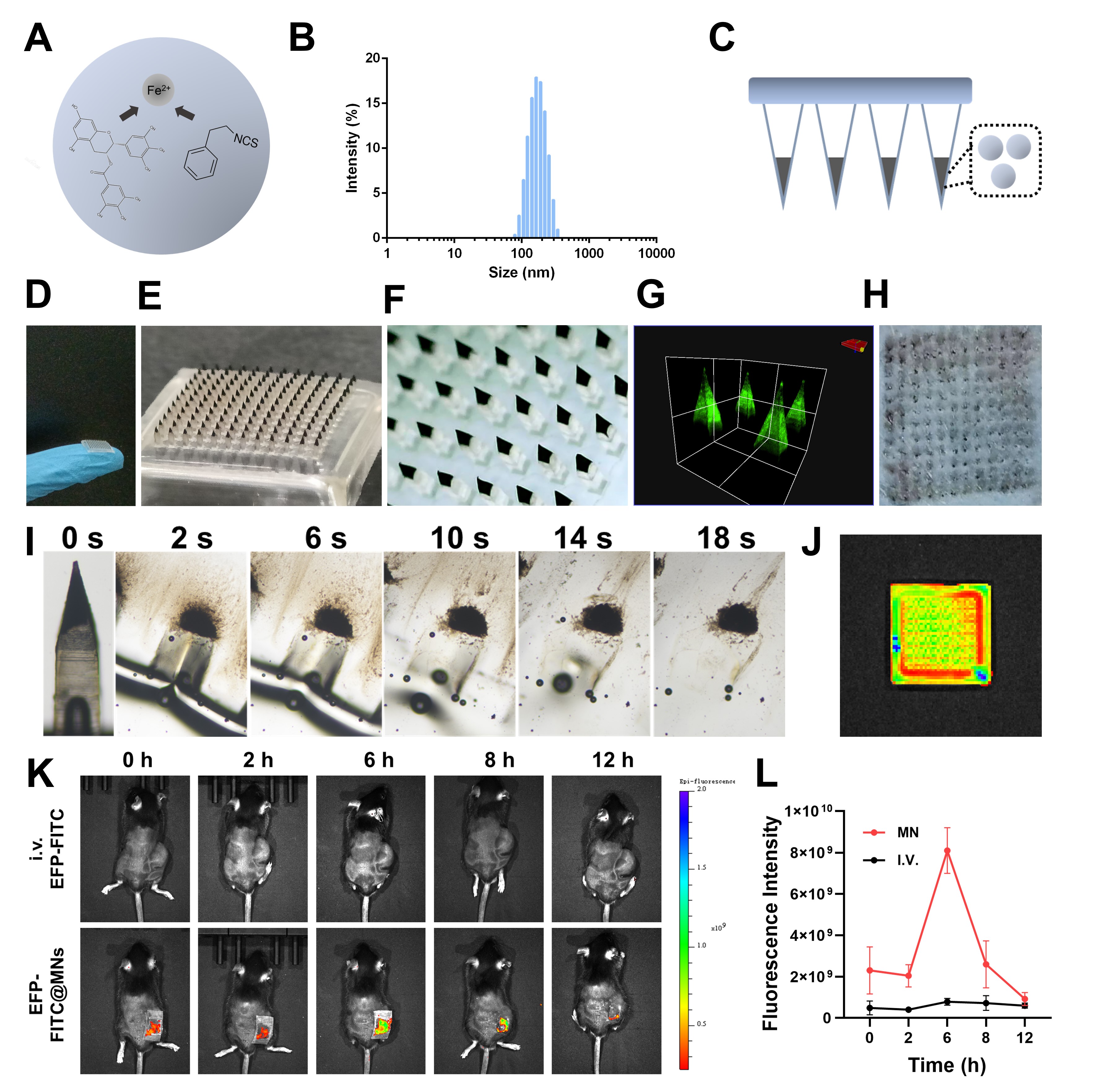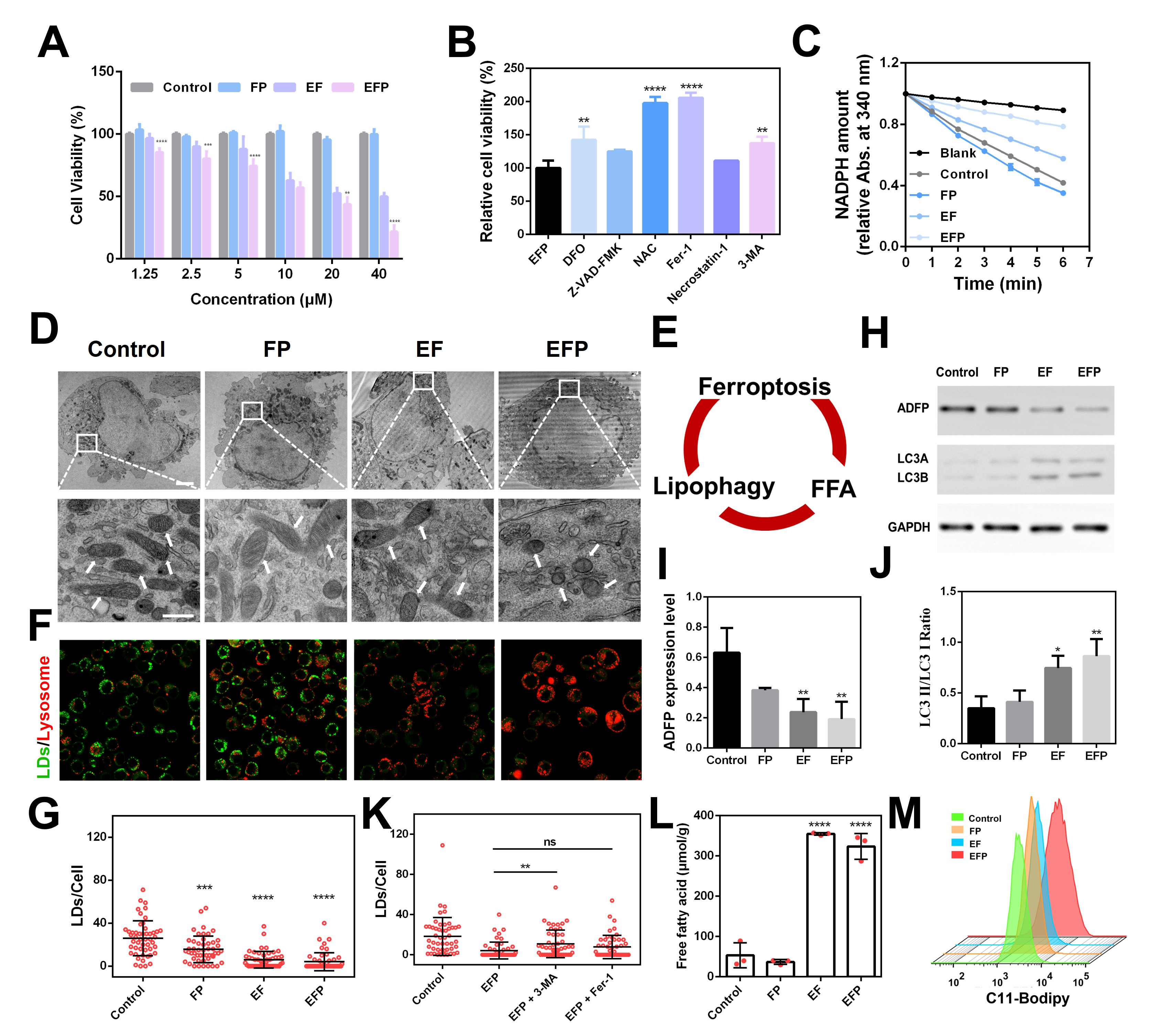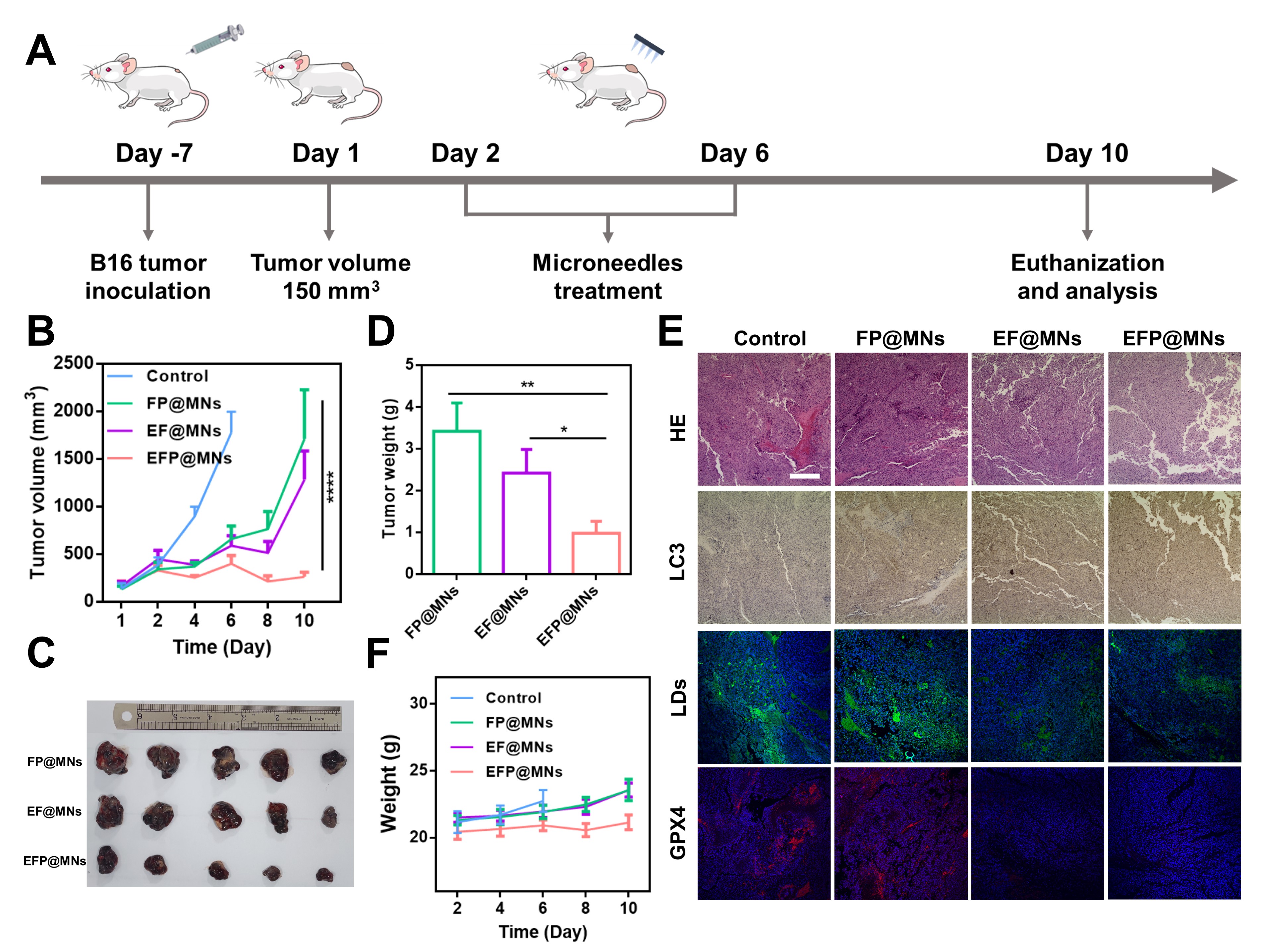Formulation and Delivery - Chemical
Category: Poster Abstract
(W1230-11-71) Dissolving Microneedle Patches for Enhanced Melanoma Ferroptosis Therapy Based on a Lipophagy-Fueled Strategy
- WW
Wenhao Wang, MS (he/him/his)
Sun Yat-Sen University
Guangzhou, Guangdong, China (People's Republic) - WW
Wenhao Wang, MS (he/him/his)
Sun Yat-Sen University
Guangzhou, Guangdong, China (People's Republic) - WW
Wenhao Wang, MS (he/him/his)
Sun Yat-Sen University
Guangzhou, Guangdong, China (People's Republic) - ZZ
Ziqiao Zhong, BS (he/him/his)
Jinan University
Guangzhou, Guangdong, China (People's Republic) - ZH
Zhengwei Huang, Ph.D. (he/him/his)
Jinan University
Guangzhou, Guangdong, China (People's Republic) - YH
Ying Huang, Ph.D. (she/her/hers)
Jinan University
Guangzhou, Guangdong, China (People's Republic) - CW
Chuanbin Wu, Ph.D. (he/him/his)
Jinan University
Guangzhou, Guangdong, China (People's Republic) - XP
Xin Pan, Ph.D. (she/her/hers)
Sun Yat-Sen University
Guangzhou, Guangdong, China (People's Republic)
Presenting Author(s)
Main Author(s)
Co-Author(s)
Purpose: Ferroptosis therapy triggered by intracellular lipid peroxidation (LPO) accumulation has been emerging as an effective tumor elimination approach. However, the insufficient intracellular free fatty acid (FFA), the key fuel for LPO production, limits the current ferroptosis therapy efficiency. Inducing lipophagy to accelerate lipid droplets (LDs) degradation was hypothesized as a potential strategy to provide rich FFA. Here, the lipophagy inducer epigallocatechin gallate (EGCG) was self-assembled with ROS producer phenethyl isothiocyanate (PEITC) via Fe2+ to form an EFP nanocomposite, which was encapsulated in dissolving microneedle patches (EFP@MNs) to serve as a robust melanoma treatment platform for lipophagy-fueled ferroptosis therapy.
Methods: The EFP nanocomposite was synthesized by a simple one-pot method, while the EFP@MNs were prepared by a three-step centrifugation method. The particle size of the proposed EFP nanocomposite was determined by a dynamic laser scattering method, while the 3D morphology of EFP@MNs was evaluated by a confocal laser scanning microscope (CLSM). After evaluating the skin insertion capacity and water-dissolving properties, the in vivo distribution of EFP@MNs was compared to the intravenous injection (i.v.) by the living imaging system. Then, the cell viability, glutathione peroxidase 4 (GPX4) activity, LPO level and mitochondrial morphology were evaluated to prove the ferroptosis effect. To prove the lipophagy-fuled mechanism, the LDs number, ADFP and LC3 expression were detected. At the last, the in vivo antitumor effect and mechanism was determined in a B16 tumor model.
Results: The EFP nanocomposite was self-assembled by EGCG, PEITC and Fe2+, which was about 151.6 nm with narrow size distribution (Fig. 1A and 1B). Then, the EFP nanocomposite was loaded into the microneedles to form EFP@MNs (Fig. 1C). The prepared EFP@MNs were of desired morphology with EFP nanocomposite loaded in tips (Figs. 1D-G), which could be inserted into mice skin and skin mimics (Fig. 1H). Upon encountering water, the EFP@MNs quickly dissolved, implying its satisficed drug release profile (Fig. 1I). Then, the fluorescence dye FITC was conjunct with EGCG to prepare EFP-FITC@MNs (Fig. 1J). The in vivo distribution results revealed that the EFP@MNs could residue in the tumor site up to 12 h while no significant signals were recorded in i.v. group, indicating the superior transdermal delivery performance of mironeedles (Fig. 1K-L). The EFP exerts an enhanced cell-killing effect, which was an autophagy-dependent ferroptosis process (Fig. 2A and 2B). The decreased GPX4 activity and shrunken mitochondrial revealed the ferroptosis effect (Figs. 2C-D). These results collaboratively proved the enhanced ferroptosis effect. Then, it was hypothesized that the enhanced ferroptosis might be ascribed to boost FFA release triggred by lipophagy (Fig. 2E). To confirm that, the levels of LDs and autophagy were measured. The reduced LDs number was revealed by LDs staining and downregulation of LDs-associated ADFP expression (Fig. 2F-I). And the increased lysosome number and upregulation of LC3II/LC3I demonstrate the activation of lipophagy (Fig. 2F, H and J). More importantly, the LDs reduction could be recovered by autophagy inhibitor 3-MA but not ferroptosis inhibitor Fer-1, revealing an autophagy-dependent process (Fig. 2K). The boosted FFA release was also confirmed, accompanied by the enhanced LPO production (Fig. 2L and M). These results collaboratively proved the lipophagy-fuled ferroptosis process. Finally, the enhanced in vivo antitumor effect of EFP@MNs was exhibited with the slowest tumor growth curve and smallest tumor weight (Fig. 3A-C). The pathological examination exhibited that the LC3 expression was upregulated while the LDs and GPX4 were downregulated, indicating the lipophagy-fuled ferroptosis straytegy in vivo.
Conclusion: In summary, upon effectively being inserted into tumors, the EFP@MNs could induce intracellular FFA burst by lipophagy and further fueled to produce LPO, enhancing ferroptosis therapy efficiency.
Acknowledgements: We are thankful for the financial support from Medical Scientific Research Foundation of Guangdong Province (Grant No. A2020167), Natural Science Foundation of Guangdong Province (Grant No. 2020A151501156), and National Science Foundation of China (Grant Nos. 82104070, 81703431, and 81673375).
 Figure 1. The preparation and characterization of EFP@MNs: (A) Schematical illustration of EFP nanocomposite. (B) The particle size distribution of EFP nanocomposite. (C) Schematical illustration of EFP@MNs. (D-F) The appearance and morphology of EFP@MNs. (G) CLSM images of a FITC-labeled microneedle patch. (H) The EFP@MNs insertion images of mice skin. (I) The water dissolving images of EFP@MNs. (J) Fluorescence images of FITC-labeled microneedle patch. (K-L) In vivo distribution of EFP-FITC in B16-tumor-bearing mice.
Figure 1. The preparation and characterization of EFP@MNs: (A) Schematical illustration of EFP nanocomposite. (B) The particle size distribution of EFP nanocomposite. (C) Schematical illustration of EFP@MNs. (D-F) The appearance and morphology of EFP@MNs. (G) CLSM images of a FITC-labeled microneedle patch. (H) The EFP@MNs insertion images of mice skin. (I) The water dissolving images of EFP@MNs. (J) Fluorescence images of FITC-labeled microneedle patch. (K-L) In vivo distribution of EFP-FITC in B16-tumor-bearing mice. Figure 2. The lipophagy-fuled ferroptosis mechanism of EFP. (A) The cell viability of B16 cells after different treatments. (B) Relative cell viability of B16 cells treated with EFP and different regulated cell death pathway inhibitors. (C) GPX4 activity of B16 cells. (D) Mitochondrial morphology of B16 cells with different treatments. (E) Schematical illustration of lipophagy-fuled ferroptosis. (F) The confocal laser scanning microscopy images of LDs and lysosomes. (G) The quantitative analysis of LDs numbers per cell. (H) The western blot images and analysis of ADFP and LC3I/LC3II expression. (I-J) Semi-quantitative analysis of ADFP and LC3II/LC3I expression. (K) The quantitative analysis of LDs numbers per cell treteted with different inhibitors. (L) The intracellular FFA level with different treatments. (M) The LPO level analyzed by flow cytometry.
Figure 2. The lipophagy-fuled ferroptosis mechanism of EFP. (A) The cell viability of B16 cells after different treatments. (B) Relative cell viability of B16 cells treated with EFP and different regulated cell death pathway inhibitors. (C) GPX4 activity of B16 cells. (D) Mitochondrial morphology of B16 cells with different treatments. (E) Schematical illustration of lipophagy-fuled ferroptosis. (F) The confocal laser scanning microscopy images of LDs and lysosomes. (G) The quantitative analysis of LDs numbers per cell. (H) The western blot images and analysis of ADFP and LC3I/LC3II expression. (I-J) Semi-quantitative analysis of ADFP and LC3II/LC3I expression. (K) The quantitative analysis of LDs numbers per cell treteted with different inhibitors. (L) The intracellular FFA level with different treatments. (M) The LPO level analyzed by flow cytometry. Figure 3. The in vivo anti-tumor effect of EFP@MNs. (A) The schematical illustration of in vivo antitumor effect evaluation. (B) The tumor volume growth curves with different treatments. (C-D) The images and weights of tumors. (E) The pathological examination of tumor tissues. (F) The body weight curves of mice with different treatments.
Figure 3. The in vivo anti-tumor effect of EFP@MNs. (A) The schematical illustration of in vivo antitumor effect evaluation. (B) The tumor volume growth curves with different treatments. (C-D) The images and weights of tumors. (E) The pathological examination of tumor tissues. (F) The body weight curves of mice with different treatments.